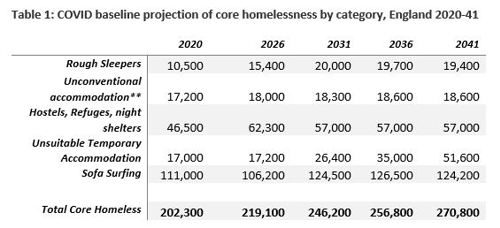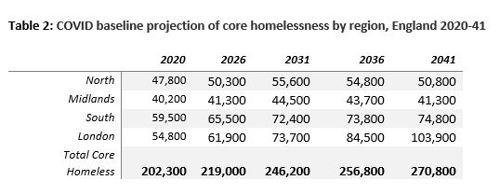Over 60,000 could be prevented from becoming homeless in next decade with Government action
22.12.2020
Figures released as Crisis opens hotels across London and begins its Christmas services for people experiencing homelessness in Great Britain
Over 60,000 families and individuals could be prevented from being pushed into the worst forms of homelessness in England in the next ten years with bold government action, according to major new research released today. With the right measures in place, rates of homelessness could be 25 percent lower by 2031 than under current projections.
The annual study, commissioned by Crisis and carried out by Heriot Watt University, shows how a package of measures including, continued investment in housing benefit, social house building and a national roll out of ‘Housing First’, could drastically reduce the number of people forced to sleep on our streets, sofa surf or spend years stuck in unsuitable temporary accommodation.
If these measures are implemented, significant reductions could be seen across the worst forms of homelessness:
- Rough sleeping could reduce by up to 62% compared to current projections
- Unsuitable temporary accommodation could reduce by up to 75%
- Sofa surfing would reduce by 13%
However, without concerted government effort, we could see 246,200 families and individuals facing homelessness by 2031, a 22% rise from current figures, released by Crisis at the start of this month, which show that over 200,000 households are without somewhere safe and secure to call home this Christmas.
Without Government action to address the root causes of homelessness, figures show:
- The number of people sleeping on our streets could be set to nearly double, with an increase of 90%
- Numbers of households stuck in unsuitable temporary accommodation could increase by 55%
- Numbers of households forced to sleep on sofas could jump by 12%
Unprecedented efforts to get people into secure accommodation where they could self-isolate - as part of the government’s “Everyone In” scheme - contributed to a drop in the number of people forced to sleep rough this year, but levels of homelessness have otherwise been rising steeply year-on-year.
As the economic impact of the pandemic sweeps across Great Britain and with unemployment set to peak in mid-2021, there are fears the post-pandemic economic downturn could see many more forced into dangerous and insecure living situations.
Crisis is warning that while actions this year have been successful in protecting people during the global health emergency, the Government needs to implement a longer-term approach or risk this success unravelling. Welfare measures to tackle poverty and a scaling up of ‘Housing First’ all could play a key role in helping to ensure that people can leave homelessness behind, and people at risk of losing their homes are prevented from doing so.
The new research on the long-term outlook for homelessness comes as Crisis opens its Christmas services for people experiencing homelessness across England, Scotland and Wales.
Because of the pandemic, the charity is unable to open its traditional centres this year and will instead be providing hotel accommodation to people who would otherwise be sleeping rough in London, to provide warmth, food and companionship, as well as introducing people to Crisis’ year-round services to help them out of homelessness for good.
As well as this, Crisis frontline teams will be providing food and wellbeing packages, advice and support services and a telephone befriending service to people experiencing homelessness across Great Britain.
Paul, who is in his 50s and from London, became homeless following the breakdown of his relationship. He slept rough on and off for a number of years before attending Crisis’s Christmas services last year. Throughout the pandemic, Paul was given a place in a hotel as part of the emergency accommodation provision, and recently moved into a flat of his own. He’s now volunteering for Crisis this Christmas.
Paul said: “When my relationship broke down, that was the catalyst for things going wrong, things just spiralled. I slept on the street for the first time about seven years ago – it was horrible. It was always wet, always cold. When I had my dog it was better, but when I was on my own it was really difficult – I just tried to keep myself to myself. It was scary, I was attacked and put in hospital.
“After I went to Crisis at Christmas last year, I started getting support. Crisis has been brilliant. When the pandemic started, they helped me get into a hotel. They’ve been there all the way through this year and have helped me sort everything out. I’ve got a nice flat now, some new warm clothes and I’m so happy to be volunteering this year.
“It only took a short while but, with a bit of help, I’m up and running. It was that little nudge I needed – just knowing someone was in my corner. I feel amazing now. I have the joy of getting up and going somewhere knowing I have a home to go back to. I know the heating’s on, my bed’s there and there’s food - it’s enough for me. I’m very, very pleased. It’s made a big difference in my character as well – I’m not so withdrawn any more, I’m finding my personality again.”
Jon Sparkes, chief executive of Crisis, said: “Since the start of the pandemic, we’ve seen unprecedented action to protect people experiencing some of the worst forms of homelessness. Today’s figures show how, while we’ve taken steps forward, we’re now at a crucial point where homelessness could either skyrocket over the next decade or can be brought down with similar bold action to what we’ve seen this year.
“Hundreds of thousands of people are set to spend Christmas without a home – this is heart-breaking. We know that with concerted efforts, such as continued investment in housing benefit, and longer-term solutions such as building more affordable homes, we can change this.
“Crisis will continue to be there for thousands of people experiencing homelessness across Great Britain, providing food, warmth and accommodation, as well as helping people to take their first steps out of homelessness, and leave it behind for good.”
People can support Crisis this Christmas by donating £28.22 which will provide people experiencing homelessness with a life changing gift of somewhere to stay, food, friendship, care and advice. Please visit http://www.crisis.org.uk/support
Notes to editors
1. Research methodology
The core homelessness estimates are calculated by combining data from a range of sources - household surveys, statutory statistics, administrative data and specialised surveys of services and their users - to produce the most up to date estimate of the worst forms of homelessness. There have been changes to the data set based on improved and enhanced data collection since the last iteration of the core homelessness series. This means the data series presented in this briefing is not a precise comparison to previous publications of core homelessness in 2017 and 2018, but the basic definition and focus is the same. The research has calculated low, mid and high range estimates, and the mid-range figures have been used.
The analysis uses evidence about the length of time over which people experience different forms of homelessness. This is necessary because different sources measure over different time periods, and it is helpful in minimising double counting. The estimates also make allowances for the extent to which different sources do or do not cover certain groups, for example people who do not apply to a local authority for assistance, or the under-representation of people who move around a lot in some surveys. For each of the five categories of core homelessness we draw on at least four (and in some cases 5 or 6) different data sources, combining these in a way which reflects judgements on the robustness of the different sources.
A sub-regional housing market model has been adapted to forecast future levels of homelessness. The model includes data from 2009-18 on private housing completions, house prices, private market rents, lettings and net changes in private rental tenure, housing vacancies, net relets of social rented housing, household income levels, poverty after housing costs (AHC). It has been necessary to adapt the modelling to factor in Covid, and potentially varying assumptions about both the depth/pattern of its impact and the duration of its effects. Essentially, and at a minimum, we now have two baselines, the original ‘business as usual’ scenario and then a ‘with-COVID’ scenario.
The figures are based on mid-point estimates and refer to households who are considered homeless at any point in time (stock) rather than the flow over the year.


The package of policy measures included in the model could potentially bring total levels of core homelessness down to 185,600 households on any given night in 2031 instead of the projected 246,300 if things continue as they are. This equates to a decrease of 25%.
2. The full package of measures included in the model are: i) increasing local housing allowance, ii) limiting evictions in the private rented sector, iii) upscaling Housing First, iv) increasing the number people being rehoused from core homelessness into social housing, v) strengthening local authorities prevention activity; vi) increasing the supply of social housing; vii) improved economic performance focused on the Midlands and North of England (‘levelling up’) , viii) a package of more generous welfare measures including the £20 Universal Credit uplift, ending the five week wait, and measures to address destitution.
